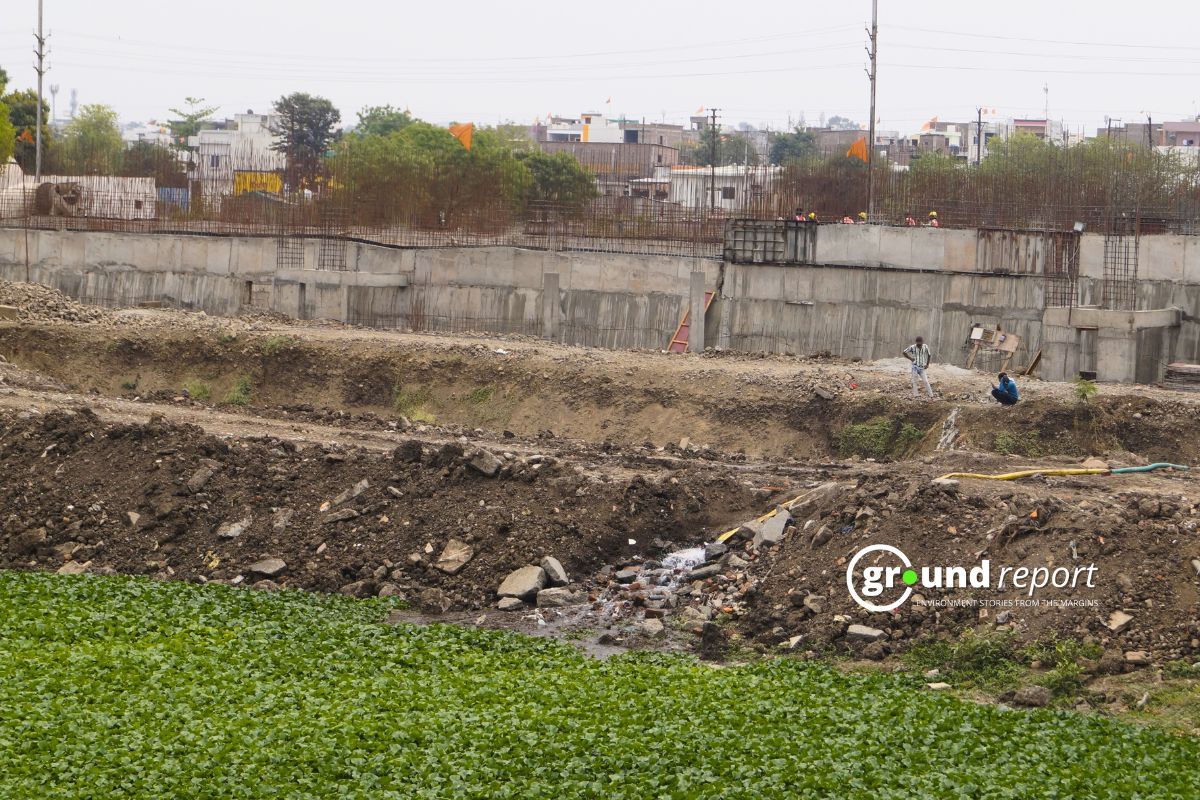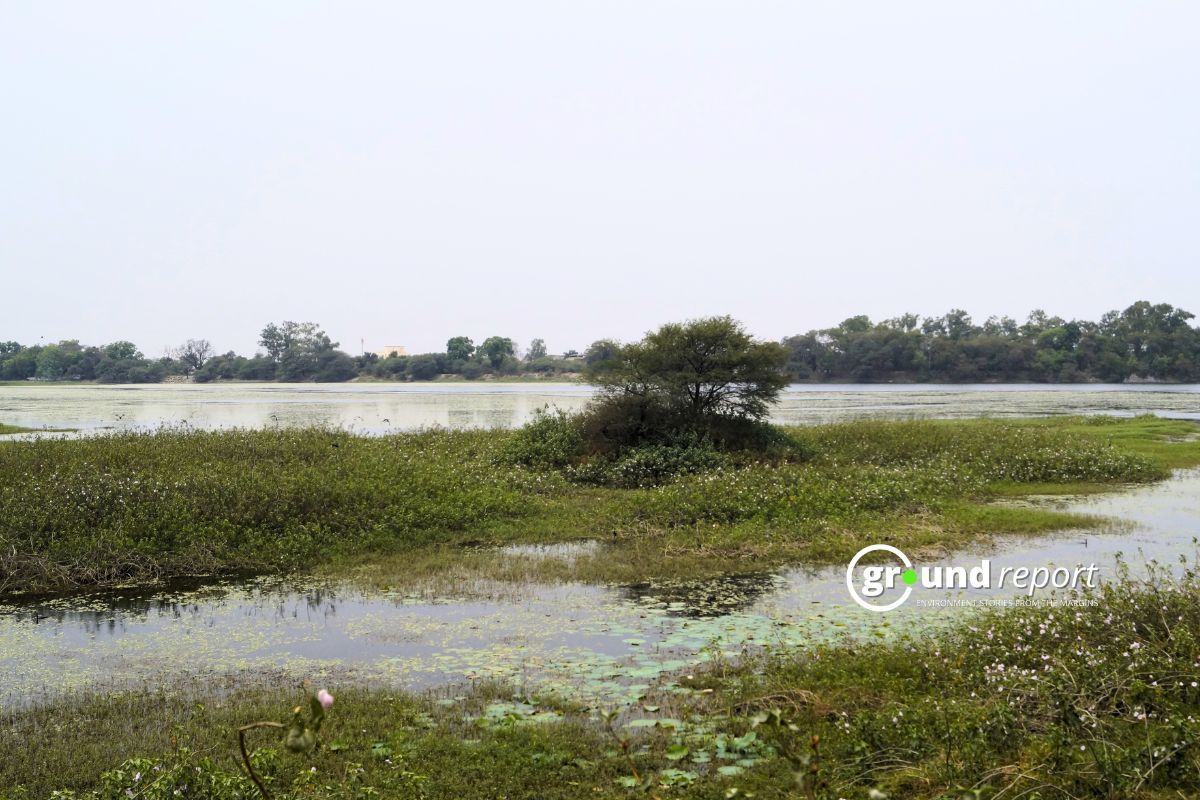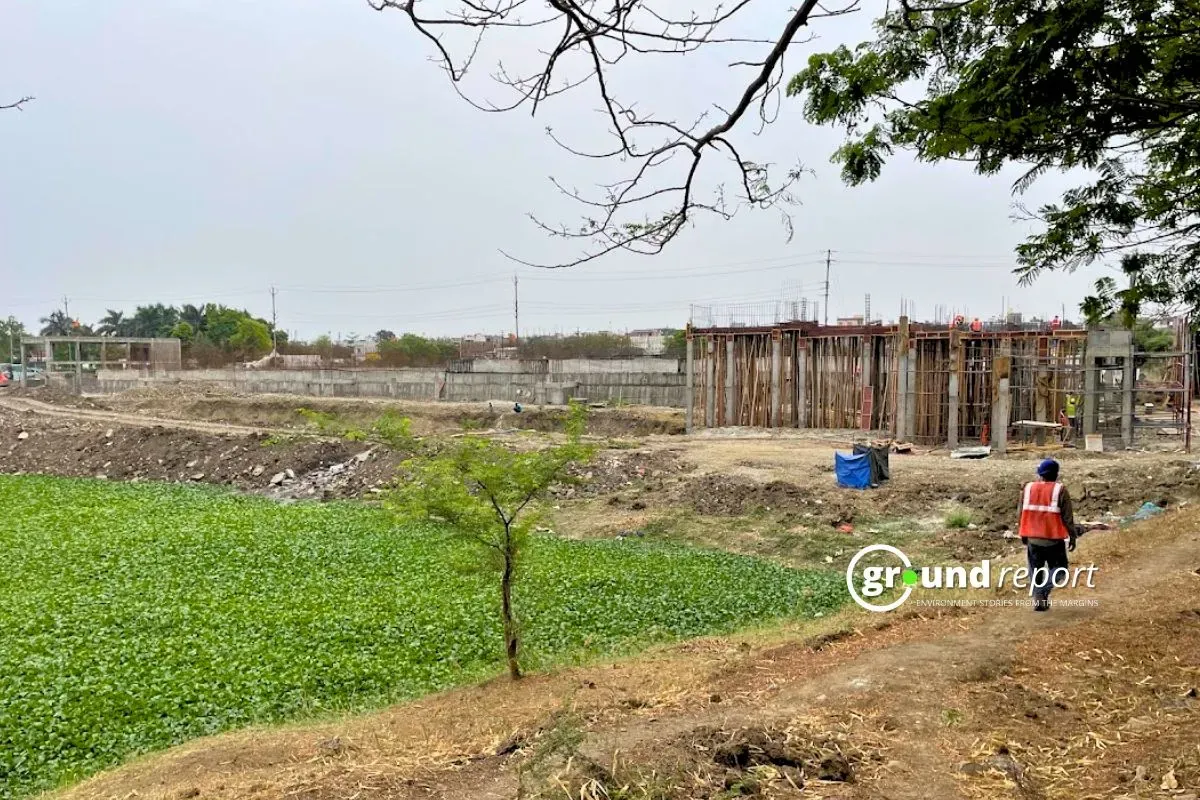The pride of the cleanest city in India is a recently inducted Ramsar site i.e. Sirpur wetland. Located on the outskirts of Indore, the century-old Sirpur Wetland was recognized as the third Ramsar site of Madhya Pradesh on 3rd August 2022. However, this honour brings the responsibility of wetland conservation to several institutions, directly and indirectly. Primarily, it is essential to ‘maintain the ecological character’ of the wetland and to plan for the “wise use“, or sustainable use, of wetland territories. And, we would expect this to be the easiest-to-implement task for a city, or municipal corporation like Indore which has been the epitome of cleanliness in the country for seven straight years.
But, when the Ground Report team visited the Sirpur Ramsar site– in April 2024– a permanent structure was being constructed near the lake, or almost on it. The construction site is nestled in the corner, deep inside the wetland away from the main entrance. The municipal corporation’s in-construction building is a sewage treatment plant (STP) of 20 MLD capacity.

Encroachment, and other construction
Apart from STP-related construction, Sirpur Wetland has an encroachment problem too. People have constructed homes on the rainwater channel of the lake, and a boundary wall, more than 100 feet long. As per some activists, the municipal corporation has been complacent in removing these encroachers, until recently on 30th May 2024, two years after Sirpur Wetland was declared a Ramsar site.

Reportedly, the construction of a big garden– Devi Ahilya Sarovar Udyan–, near the Prajapati Nagar area of the lake, is done at the cost of the lake’s catchment area. Here, several columns have been cemented. Some other reports claim offices and other permanent structures are also being built.
Kishore Kodwani, an activist focused on water conservation in Indore, said,
“A garden has been made by putting soil inside the pond and a concrete wall has been erected, the backlog of which will create big problems in the coming time.”
He questions whether permission was taken from the Environment Impact Committee for this construction.
IMC removed the encroachments, but construction of the STP, and the big garden continues.

Legal construction?
But, does this construction come under the ambit of ‘sustainable usage’, or does it adhere to 2017’s Wetland Conservation and Management Rules?
As per 2017 rules, no permanent construction except boat jetties, within 50 meters ‘from the mean high flood level observed in the past ten years’ is allowed. Furthermore, only community-based ecotourism can be allowed, with negligible construction. In the same regulations, it is mandatory to determine the ‘zone of influence’ of the wetland i.e. any construction activity in this zone can impact the nature of the wetland.
IMC argued, that due to the unavailability of government land in the upstream area of Sirpur wetland, they had to build the STP on that site itself. And, this land is ‘within 50 meters of the FTL(Full Tank Limit) of the lake’.

Petition, and NGT case
Bhopal-based RTI activist and environmentalist Rashid Noor filed a petition in NGT against the construction of STP. The petition states, [the construction] would harm the ecology and biodiversity of the wetland site. In the coming times, the obstruction caused by this construction will impact the flood areas, rainwater drains, buffer areas and agriculture in the surrounding area.
The petition states that the construction violates the Environment Protection Act 1986, Water (Prevention and Control of Pollution) Act 1974, Air (Prevention and Control of Pollution) Act 1981, Wetland Conservation and Management Rule 2017 and Articles of Ramsar Convention and Notification.
The National Green Tribunal (NGT)’s Central Bench, while hearing the matter on 14th March 2024, constituted a joint committee and ordered it to submit a factual report within 6 weeks. After the order of the NGT, on 13th April 2024, the Joint Committee inspected the Sirpur Wetland Site. During the inspection, it was found that the sewage of the settlements located in the catchment of Sirpur Lake meets Lower Sirpur Lake through a drain. To treat it, the Municipal Corporation is constructing an STP, within 50 meters of the full tank level.
Municipal Corporation’s View

A look at the timeline reflects Indore Municipal Corporation’s (IMC) lack of compliance with the rules.
In October 2021, the process of permission and tender for the construction of STP i.e. one year before Sirpur Wetland was declared a Ramsar site. The project report was sent to EPCO–Environmental Planning & Coordination Organisation – of the Madhya Pradesh government for financial assistance in November 2021. On 22nd April 2022, an agreement was signed with M/S Seema Lab HJCC Infra Solutions to build the STP. This company was supposed to start the work in May 2022. However, the work could only start in 2023. Here, IMC argued that all the paperwork for the construction was completed before Sirpur Lake was declared a Ramsar site in August 2022.
Important to mention, that IMC started construction without Consent to Establish (a CTE) Certificate from the MP Pollution Control Board. As per the NGT order, the approval of the same is still pending.
Bad management, and negligence
The NGT’s joint committee constituted to inspect the construction site, found water hyacinth grown on the lake’s surface. Water hyacinths are detrimental to the lake ecosystem. Experts suggest that the mixing of untreated sewage in the lake is the reason behind the weed growth. IMC told NGT that the sewer system network in the nearby settlements is of low capacity. Hence, the greywater backflows and gets mixed in Sirpur Lake, eventually polluting the lake. Therefore, the STP construction’s purpose was to prevent sewage from coming out of nearby settlements – located in the catchment of Sirpur lake(s).
Sirpur Wetland is home to 189 bird species, making it an important birdwatching site. It has a wealth of plants and animals, including endangered species: it supports about 175 terrestrial plant species, six macrophytes, 30 natural and cultured fish species, and eight reptiles and amphibians.
An interpretation centre, planned to educate visitors about Sirpur wetland’s biodiversity and ecology, has a budget of Rs 2.5 crore. A half-constructed, and fully abandoned building, resides 100 metres from the back entrance of the lake, awaiting completion. Bhalu Mondhe – a member of the Indore District Wetland Conservation Committee– said that the senior officials in IMC lack the motivation to complete it. Not just this, the Mondhe critically questioned the authorities and said their short-sightedness to not take recommendations from the relevant committees for wetland conservation.
The ‘Ramsar Site’

With the city’s expansion, the Sirpur Wetland, spread over 161 hectares, faces the evident challenges of urbanisation. The lake(s) was built 130 years ago in the 19th century by Maharaja Shivajirao Holkar to supply water to the city of Indore. Earlier, surrounded by forests and fields, residential construction, and encroachment have turned it into an urban wetland. Today, about one million people reside around the lake(s) hurdling the watershed of the wetland.
Sirpur wetlands, like other Ramsar sites, are wetlands of ‘international importance’. But, these tags don’t change the conservation approach. For example, Bhopal’s Bhoj wetland may be delisted from the Ramsar convention list due to ‘possible damage to its ecological character’, due to several construction activities. There are other examples of negligence in the conservation of the Ramsar site(s) by the authorities.
There is a push to get the ‘Ramsar site’ tag among state authorities. The Union Government through the National Program for Conservation of Aquatic Eco-system (NPCA) is investing in wetland conservation activities. However, such neglect of rules and regulations by the conservation authorities becomes a bane in India’s efforts for climate change.
Keep Reading
Indore Reviving Historic Lakes to Combat Water Crisis, Hurdles Remain
Indore’s residential society saves Rs 5 lakh a month, through rainwater harvesting
Explained: What are Wetlands and Why are they important?
Follow Ground Report for Environmental News From India. Connect with us on Facebook, Twitter, Koo App, Instagram, Whatsapp and YouTube. Write us on GReport2018@gmail.com and subscribe our free newsletter.








